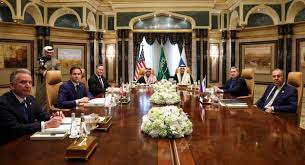Amidst reports indicating a possible meeting between Donald Trump and Vladimir Putin next week, officials of both sides have taken major steps toward de-escalating the war in Ukraine.
After high-stakes discussions in Saudi Arabia, both sides have agreed on four guiding principles aimed at finding a peaceful resolution to the conflict. This marks an important shift in Washington’s approach to Moscow.
The talks, which were the first such direct negotiations in over three years, have sparked concern in Kyiv and among European officials, who fear that Trump’s push for peace could lean in Putin’s favor. While Ukraine was absent from the discussions, both US and Russia have agreed to form a high-level team to work on negotiations and explore economic opportunities that might arise from the end of the war.
Speaking to reporters at his Mar-a-Lago estate, President Donald Trump dismissed Ukrainian concerns about being left out of the talks. He argued that Kyiv should have already reached an agreement with Russia years ago, stating, “Well, you’ve been there for three years. You should have ended it three years ago.”
He also suggested that Ukraine was partly to blame for the conflict, saying that the country should have made peace earlier. “I think I have the power to end this war,” Trump added, further stirring controversy. His comments underscore his long-standing position that direct negotiations with Putin could lead to a quick resolution.
However, Ukrainian President Volodymyr Zelenskyy has rejected the idea of a peace deal negotiated without Ukraine’s involvement. Speaking in Turkey, Zelenskyy highlighted that Ukraine would not accept any agreement made ‘behind our back.’ His statement reflects widespread fears that a deal could leave Ukraine vulnerable and compromise its sovereignty.
Many Western leaders believe that any peace agreement must reflect the interests of Ukraine, Russia, and Europe alike. The US has attempted to reassure its allies by stating that Washington has consulted with European nations throughout the process, but the concern remains that negotiations are moving too quickly without clear input from Kyiv.
Russia’s Red Lines
Throughout the Saudi talks, Russia’s Foreign Minister Sergey Lavrov and Putin’s senior foreign policy advisor, Yuri Ushakov, made it clear that Moscow’s demands for peace include significant territorial concessions and security guarantees. Lavrov, reiterated Russia’s firm stance against NATO expansion and warned that any peacekeepers in Ukraine, especially those from NATO countries, would be unacceptable.
“We explained to our colleagues today what President Putin has repeatedly stressed: that the expansion of NATO, the absorption of Ukraine by the North Atlantic alliance, is a direct threat to the interests of the Russian Federation,” Lavrov stated, underscoring one of the key factors behind the war.
Despite these firm positions, both sides agreed to continue working toward a resolution. The creation of a high-level team to facilitate talks signals a willingness to engage in meaningful dialogue, even as the specifics of a potential peace plan remain unclear.
After the talks, US Secretary of State Marco Rubio said that the process would be ‘long and difficult,’ but necessary for a lasting peace. The four principles agreed upon by the US and Russia include appointing special envoys to continue the negotiations and discussing broader issues such as territory and security guarantees. In Riyadh, the both also agreed to resume diplomatic dialogue on other issues, with hopes of normalizing relations.
